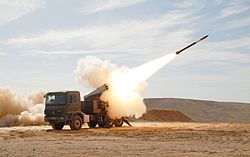| Fire Support Command | |
|---|---|
| Vuursteun Commando (VustCo) | |
 Emblem of the VustCo | |
| Founded | 25 January 2013 |
| Country | |
| Branch | |
| Type | Artillery |
| Size | c. 500 active personnel |
| Part of | Operational Support Command Land |
| Garrison/HQ | Artillerie Schietkamp in 't Harde |
| Commanders | |
| Current commander | Colonel Michel Roelen |
The Fire Support Command (Dutch: Vuursteun Commando, VustCo) is the artillery arm of the Royal Netherlands Army. [1] The command consists of 41 Artillery Battalion, a staff, the Fire Support School and the artillery training grounds and is part of the Operational Support Command Land.
Contents
The command was established on 25 January 2013 through amalgamation of the 14 Field Artillery Battalion (Dutch : 14e Afdeling Veldartillerie) and the 11 Horse Artillery Battalion (Dutch : 11 Afdeling Rijdende Artillerie).








